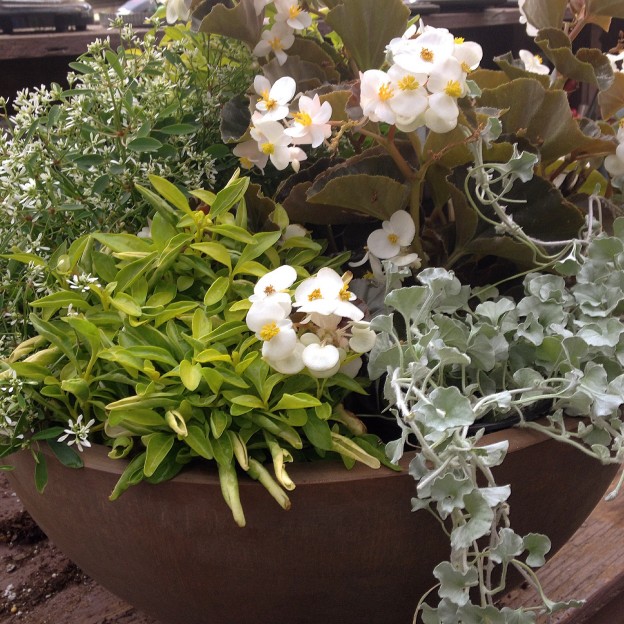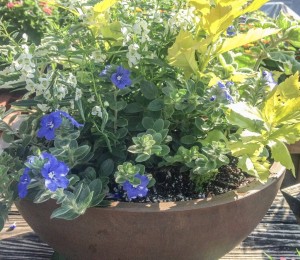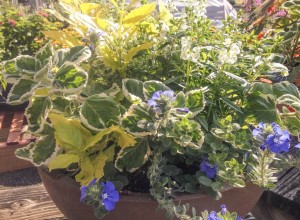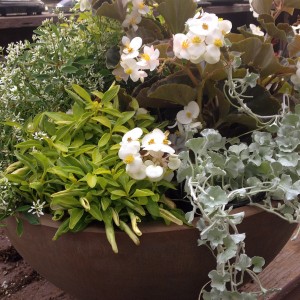Recently the weathermen called for a pretty decent chance of rain, which, fortunately, finally did materialize. Now, if you’re in the Birmingham area and are a homeowner or even just have a small plot to garden, you were well aware, prior to the welcome rain showers of recent days, that it was getting pretty darn dry out there. And, if you, like me, don’t have an irrigation system, that means dragging around hoses.
Personally I don’t mind this. Of course, it might be better if I weren’t watering pretty extensively by hand early in the morning at home, when it’s needed, then arriving at Oak Street Garden Shop, my home away from home, and, you guessed it, immediately pulling out the hoses to water the plant inventory on these long, hot late summer days.
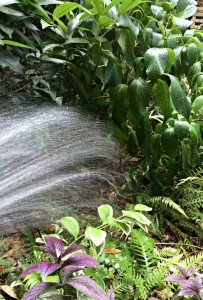
Hydrangeas are the first to wilt from lack of water…
Truthfully, though, I sort of like hand watering. Sure, I could set the sprinkler to run (My husband prefers this since he has other things he’d rather be doing.), or set out soaker hoses to get water right where it’s needed at the roots. If I had an irrigation system, it would surely save a lot of time and energy…assuming it was set to run properly at the correct intervals. (Now that I really think about it, I believe having an irrigation system would cause me more anxiety, since I would need to know that everything was set just right and was still working during really dry spells.)
No, watering by hand keeps me in touch with what’s going on in my personal plant kingdom, and I also really appreciate this quiet time to just be still and think. Moving from plant to plant and back again, trying to water as deeply as possible, (Watering less frequently but deeply should be the goal.) I see things more closely, and make mental notes of things I may need to address. Overwatering kills more plants than underwatering. When roots of a plant are waterlogged and can’t get oxygen, they basically drown, and, even though they’ll look like they need water (wilted leaves), no amount of water will bring them back.
Sometimes plants wilt simply because they’re hot and will begin to revive by evening. Plants that have gone past the point of very, very dry when finally watered will have many yellow leaves…a sign of stress. It’s best if you can learn to water before a plant gets so dry. This means getting to know what your individual plants want. But, if you’re not sure, it’s always better to err on the side of more dry than too wet, unless they’re bog plants or those you know want consistently wet soil.

Water as early in the day as possible…
As I water, I think back to the drought of 2007. Surprisingly, most of my perennials, shrubs, and trees did indeed survive that awful summer, and I learned a hard lesson on how better to read each one for signs of stress, hose in hand. It was like a personal watering triage each time I pulled the hose out. Water the hydrangeas more…those spiraeas will need less…skip over the yuccas, rosemary and sedums… Thankfully, now hand watering is once again a more relaxing endeavor.
Irrigation systems do make life easier, for sure. But, when I see them running irresponsibly, either during the hottest portion of the day (So much water is wasted, evaporating into thin air.) or in the midst of rain storms, it worries me. Water is a valuable resource, and we all need to remember to be responsible in our water usage, whether it be inside our homes or out. Install a rain sensor on your system if you haven’t already.
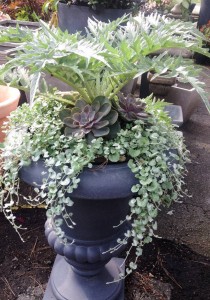
This planting is easy to hand water since it needs to be dry…
The inventory at Oak Street Garden Shop is watered individually, by hand daily, and this has turned out to be quite efficient. We decided to completely dismantle the entire irrigation system a number of years ago, and now we water exactly what needs it. No more groups of plants getting too much water while others parch. I prefer this and feel more like a steward of my plants, both at home and at work. For me, it’s more personal, and I like that.
If you have an irrigation system, please use it responsibly. Know how it works and have it checked regularly by a professional irrigation specialist. As your trees and shrubs grow, sprinkler heads often need to be adjusted to continue to water efficiently. Irrigation systems can definitely be wonderful additions in helping maintain your landscape when properly installed and monitored. Take a look HERE for more information.
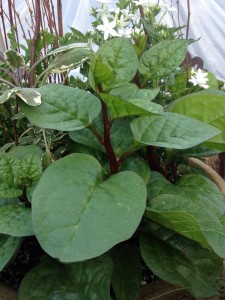 One of our growers called the other day, offering a few trays of a plant called Malabar Spinach. “It’s a heat tolerant green that we can grow in the summer,” she said. “It also grows like a vine with really big, spinach-like leaves and pretty ornamental red stems.” Well, how could I resist that? I ordered a couple of trays, received them, and promptly planted some in a couple of combination planters.
One of our growers called the other day, offering a few trays of a plant called Malabar Spinach. “It’s a heat tolerant green that we can grow in the summer,” she said. “It also grows like a vine with really big, spinach-like leaves and pretty ornamental red stems.” Well, how could I resist that? I ordered a couple of trays, received them, and promptly planted some in a couple of combination planters.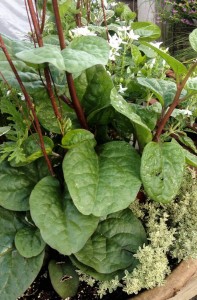

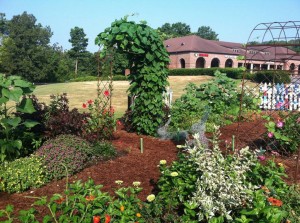
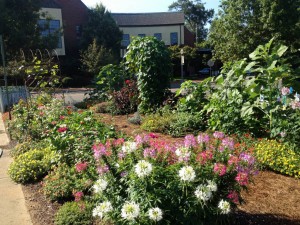
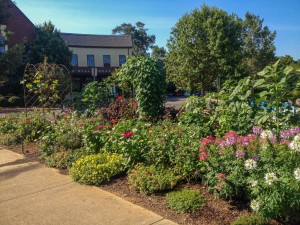
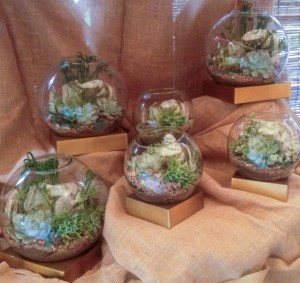

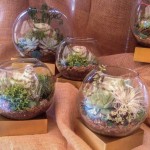 Since these terrariums are open at the top and the store gets plenty of light,
Since these terrariums are open at the top and the store gets plenty of light,  Some of the plants used include: Rhypsalis, various Echevarias, Albuca spiralis, Cactus, Haworthia, various Tillandsias, and Portulacaria afra, sometimes called a miniature jade plant.
Some of the plants used include: Rhypsalis, various Echevarias, Albuca spiralis, Cactus, Haworthia, various Tillandsias, and Portulacaria afra, sometimes called a miniature jade plant.



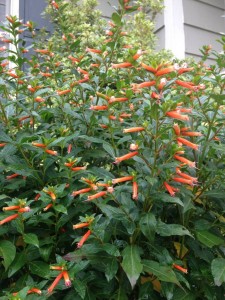
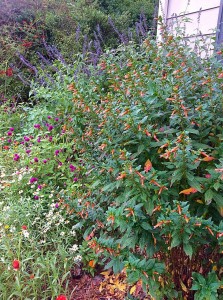 I will cut it back some if it gets too “leggy” looking in my front bed. You can alleviate this problem by placing it behind mid-height annuals like angelonia, some salvias, gomphrena, or even foliage plants like sun caladiums or coleus. So, get out in your garden and scout out a place that’s sunny, protected and within easy sight lines and try at least one cuphea so you can watch the hummers zinging by too. You won’t be sorry!
I will cut it back some if it gets too “leggy” looking in my front bed. You can alleviate this problem by placing it behind mid-height annuals like angelonia, some salvias, gomphrena, or even foliage plants like sun caladiums or coleus. So, get out in your garden and scout out a place that’s sunny, protected and within easy sight lines and try at least one cuphea so you can watch the hummers zinging by too. You won’t be sorry!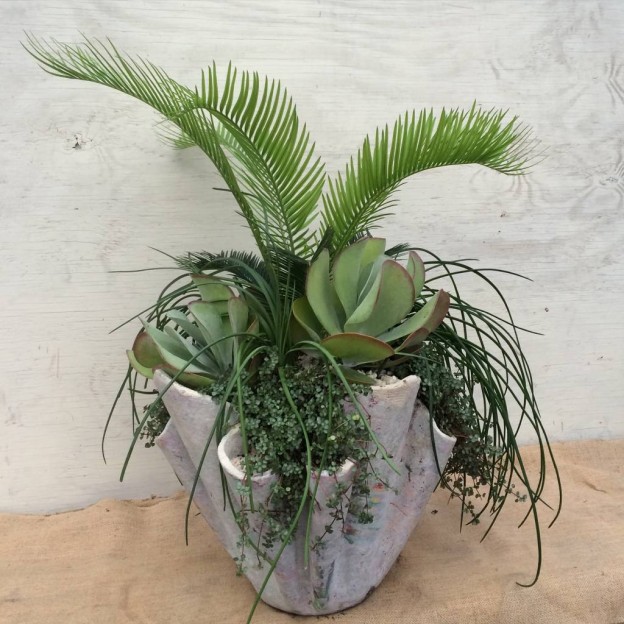
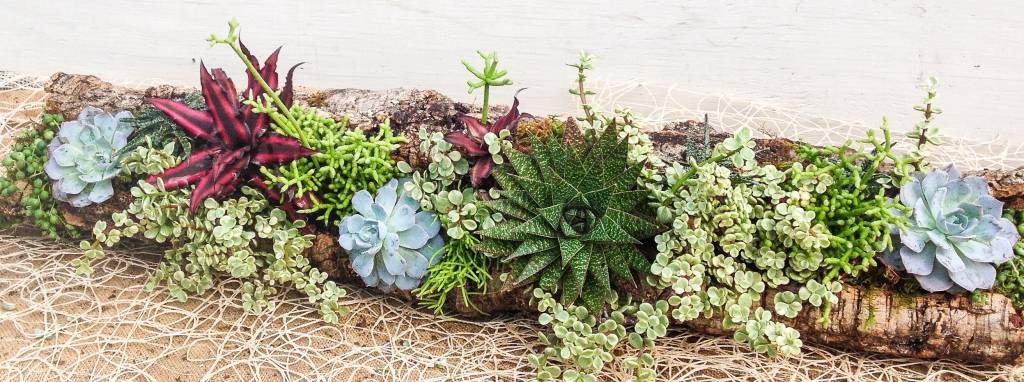 While parts of the country are enjoying an unusually cool summer, here in the heart of the south the temperature and humidity can still soar. Unfortunately, even nighttime temperatures rarely provide respite from the unending heat, though, thankfully, we (and our plants!) have had a couple of welcome breaks this year.
While parts of the country are enjoying an unusually cool summer, here in the heart of the south the temperature and humidity can still soar. Unfortunately, even nighttime temperatures rarely provide respite from the unending heat, though, thankfully, we (and our plants!) have had a couple of welcome breaks this year.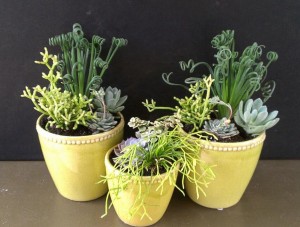 While there are plenty of
While there are plenty of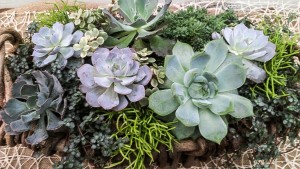 The basket planting shows a tiny leaf blue-green succulent-like plant that is actually a Pilea called ‘Aquamarine’. It has fast become a favorite for succulent and other arrangements in containers. The tiny leaves grow quite quickly, mingling with other plants and eventually trailing, seemingly indefinitely! This mixture also has echevarias, workhorse succulents that can grow to enormous proportions.
The basket planting shows a tiny leaf blue-green succulent-like plant that is actually a Pilea called ‘Aquamarine’. It has fast become a favorite for succulent and other arrangements in containers. The tiny leaves grow quite quickly, mingling with other plants and eventually trailing, seemingly indefinitely! This mixture also has echevarias, workhorse succulents that can grow to enormous proportions.
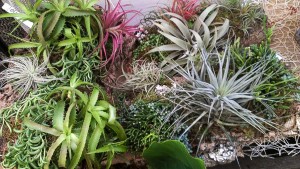 Succulent plants and
Succulent plants and 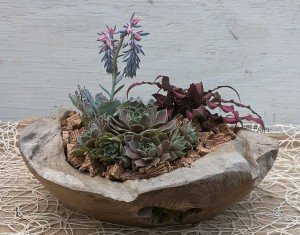 The wooden bowl shows an old favorite, sempervivum or hen and chicks, a well known succulent and widely available in many rosette colors. One thing we’ve learned about “semps” is they really do appreciate a bit of shade in the afternoon here in Birmingham. Maybe it’s our constant humidity. At any rate, a touch of shade seems to help.
The wooden bowl shows an old favorite, sempervivum or hen and chicks, a well known succulent and widely available in many rosette colors. One thing we’ve learned about “semps” is they really do appreciate a bit of shade in the afternoon here in Birmingham. Maybe it’s our constant humidity. At any rate, a touch of shade seems to help.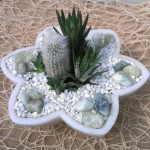 Another cactus called ‘Old Man’ and a little succulent called Haworthia are at home in a small marble container. There are no drainage holes in this piece, so careful watering must be done sparingly.
Another cactus called ‘Old Man’ and a little succulent called Haworthia are at home in a small marble container. There are no drainage holes in this piece, so careful watering must be done sparingly.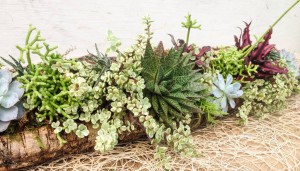 Finally, a long, very narrow piece of cork bark is home to a varied selection of succulents including Portulacaria afra, sometimes called miniature variegated jade plant though it’s a different species. Its small, cream-variegated leaves on reddish stems are striking combined with the echevarias, haworthias, Cryptanthus, and Senecio rowleyanus or string of pearls (not shown in this picture). With bright light and a light hand with water, this planting should flourish.
Finally, a long, very narrow piece of cork bark is home to a varied selection of succulents including Portulacaria afra, sometimes called miniature variegated jade plant though it’s a different species. Its small, cream-variegated leaves on reddish stems are striking combined with the echevarias, haworthias, Cryptanthus, and Senecio rowleyanus or string of pearls (not shown in this picture). With bright light and a light hand with water, this planting should flourish.